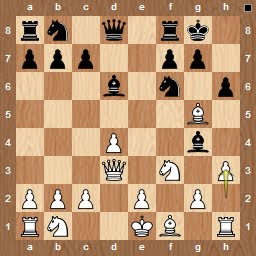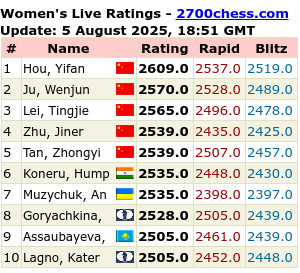I admit, I wasn't really prepared for this...work and other issues prevented me from really applying and preparing myself, so right up to the last minute I was unsure of what to play, but eventually ( and judging by post-match chat, correctly ) I avoided my usual 1.e4 and went for 1.f4 : Bird's Opening.
I have played Bird's Opening quite a lot in the past, and enjoyed the (strange) positions arising, although I have to admit have only once, in a serious game, played against my opponent's reply of 1...e5, known as From's Gambit.
As an aside, this is named after a Danish player called Severin From, who also gave the chess world the Danish Gambit as, although not the first to play it, he used it ( aggressively, but not particularly successfully ) at a tournament in Paris in 1867. Not that he won the tourney : in the company of Steinitz, Winawer and de Vere, he came second from last. Despite this, he is rated as 2483 and 16th in the world at the time, by Chessmetrics. Pretty good, I'd say, even in 2010, let alone for an amateur in 1867 !
As in all gambits, the point of offering a pawn is to obtain compensation in the form of attacking play or a better position, and this is what my opponent did. However, I think he didn't continue in the spirit of the gambit, and with a couple of quieter, less aggressive moves (such as 9...Bh5 and 11...Nd7), gave me the chance to slip back into the game.
Mistakes on both sides as usual, but an enjoyable time...
So...1. f4 e5 2. fxe5 d6 3. exd6 Bxd6 4. Nf3 Nf6 5. d4 are the standard moves usually followed by 5..Ng4.
Instead Black plays
There follows 6. Qd3 O-O 7. Bg5 h6 and I choose to play 8.h3.
Not the best...as it allows 8...Bg3+, which I am sure I didn't even consider. Irritating, but is it that bad as its not followed up so aggressively ?
Instead, I should have played 8.Bxf6 Qxf6 9.Nbd2 Re8 10.O-O-O, giving a decent position, and a castled king.
However, after 8...Bg3+ 9.Kd2 Bh5, Whiteis in a messy position, but not so bad.
Better for Black was too be more aggressive with 9...Bxf3 opening up the position.
The game continued 10. Bxf6 Qxf6 11. Nc3 Nd7.
Not sure that was the best. It connects the rooks, but better might have been Bg6 attacking the Queen, with a follow up of Nc6. Worse from Black's view Nd7 allows time for 12. Ne4, with an attack on the Black Queen allowing me to exchange off that nasty dark-squared Bishop after 12...Qg6 13. Nxg3 Qxg3 and then things don't look so bad for White.
However, I rush ahead of myself and opt for 14.h4 intending to drive away the Queen, instead of a more sensible/slow Rd1 to allow the King eventually to slip away behind the queen-side pawns.
But chess is not perfect, so when Black plays 14...Rfe8 I am off the hook as I see the crude Qf2 threat and can play 15.Rd1 getting back on the path of hiding the King.
I think that Black should have checked with Qf4, despite the obvious e3 to chase him off, instead of 15...Bg6 which allows the White Queen into the open with 16.Qb3. The key point for white's Queen, is to stay on the third rank to defend the e3 square. The response of 16...b6, gives me time to play 17.Kc1, and the King is safe !
At this point, I can say that White has equalised ! Strange, but probably true. I now expected Qf4+ and a further attack, but no, the rather strange 17...Rad8 was played. I am not sure what was in mind here, but 18.e3 allows me to finish the defence and think about an attack.
Some manoeuvring moves now, but after 21...Qe6 I have the chance to exchange Queens...
I shouldn't have : 22.Bc4 was better !! How did I miss that ?
Not sure if BxQ was better than RxQ. I had worked through that RxQ left me with an equal game ( 23.Bd3 BxB 24.Rxd3 Rde8 25.Re1 ) so was not particularly worried.
After that , 23.d5 is obvious with 23...Bf5 following ( although Bg4 is better as the e-pawn is hard to defend, and the bishop and a-rook remain stuck) . Here, I think 24.Nd4 is quite good, but I didn't see it. According to my silicon friend this puts White ahead enough.
I played 24.Bd3, intending to prompt the exchange towards an advantageous end-game. The next few moves put me nearer to a draw, although I missed 26.Nd4, which may have given me an edge. (Interesting how opportunities for playing the same good move arise at different points in a relatively short period. Is this a 'positional chess law'? )
Regardless, after my apparent mistake of 26.Re1 we agree a draw with Nf6.
I cannot play c4 to defend e5, so its probably a fair result, but under "Sofia rules", I dare say a continuation would be interesting to say the least to discover the 'chess truth' of it. However, since this is part of a team match, and the draw gives us match-point, I am happy to take it.
Is this a bad result for Bird's Opening ? I don't think so.
I would play this again. My 8.h3 was evidently wrong. Bxf6 is much better,simplifies and allows White to keep the gambit pawn. In fact Bxf6 earlierthan my move 10, is much better. Aiming to castling Queen-side will help, and I don't think that White is too bad.
On the other hand, I'm not sure that 1.f4 preserves White's opening advantage. It normally gives a time advantage, and often throws Black onto his own initiative, but with a gambit move, maybe this disappears too quickly ?
Ah, by the way...post-match chat revealed that my opponent had prepared against my usual Scotch game, so I I should think of this Bird's opening as psychological surprise/victory at least !
Food for thought !
Included in the games below are my previous From gambit ( a win, I love the combination started by 23.Nc7, check it out ) plus Severin From's original gambit game and one of his 1867 games against SymonWynawer in the Paris tournament ( he lost most of them., including the one shown :). Strangely, in the "From Gambit"game versus Mollerstrom, he plays Nh6..weird to say the least, but this was 1862 !










0 comments:
Post a Comment